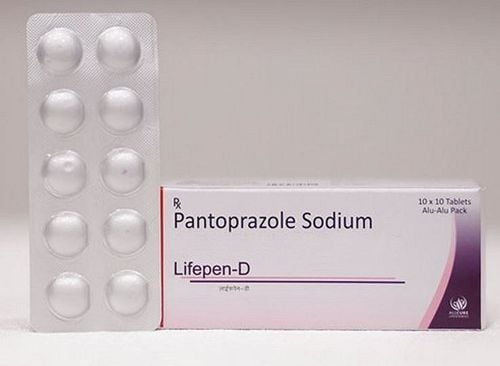This is an automatically translated article.
The main ingredient of Quazimin is L-arginine L-aspartate. It is used to aid in the treatment of functional impairments such as fatigue, weakness, weight loss, loss of appetite, indigestion, memory disturbances, and sleep-related problems.1. What is Quazimin?
Quazimin medicine with the main ingredient containing L-arginine L-aspartate has the effect of maintaining hyperammonemia, supporting dyspepsia and nutritional supplements.
Quazimin is prepared in the form of an oral solution, yellow color, characteristic aroma of flavoring and sweet taste.
2. Effects of Quazimin
Effects of Arginine:
Stimulates pituitary gland to release growth hormone and prolactin; Stimulates the pancreas to release two important hormones, glucagon and insulin; Involved in the urea cycle; Increases serum glucose and gastrin concentrations; Competitively inhibits tubular reabsorption, thereby increasing urinary protein excretion. The effect of the component Arpatat:
This is the salt form of aspartic acid; It is a non-essential amino acid, often used to supplement the daily diet. Quazimin is indicated for treatment in the following cases:
Maintenance treatment of hyperammonemia in people with carbamylphosphate synthetase and ornithine carbamyl transferase deficiency; Maintenance treatment for people with hyperammonemia caused by citrulinemia, arginosuccinicuria; Supportive treatment of signs of dyspepsia; Improve exercise capacity in people with stable cardiovascular disease; Nutritional supplements for people with urea cycle disorders such as type I and II hyperammonemia, hypercitrulinity, arginosuccinicuria or N-acetyl glutamate synthetase enzyme deficiency; Support for supplementing essential nutrients for the human body.
3. Undesirable effects of the drug Quazimin
Some unwanted effects may be encountered when treated with Quazimin.
Common side effects:
Headache, frostbite; Nausea, vomiting, hyperthermia; Flushing and local venous irritation. Rare side effects:
Pain, redness, edema on the skin; Anaphylactic reactions; Decreased platelet count in the blood. Possible side effects of unknown frequency:
Phlebitis; Hypotension; Abdominal cramps; Release insulin, glucagon, prolactin; Increased blood nitrogen and serum creatinine levels. If in the process of using Quazimin there are any adverse effects, you need to notify your treating doctor or pharmacist for appropriate supportive measures.
4. Usage and dosage of Quazimin
How to use Quazimin:
Take Quazimin orally; Break the ampoule and drink the solution directly in the tube or can be diluted with water for easy drinking; The time to take the drug is before the main meals or right when there are signs of disease. Maintain hyperammonemia in people with impaired carbamylphosphate synthetase levels, ornithine carbamyl transferase deficiency with the following dosage:
Newborns: 146 mg arginine aspartate/kg daily, divided into 3-4 times; Children from 1 month to 18 years old: 146 mg arginine aspartate/kg per day, divided into 3-4 times. Maintenance treatment for people with hyperammonemia caused by citrulinemia, arginosuccinicuria:
Newborns: 146 - 255 mg arginine aspartate/kg/time, taking 3-4 times daily with food. Adjust dose according to individual patient's response; Children from 1 month to 18 years old: 146 - 255 mg arginine aspartate/kg/time, take 3-4 times daily with food. Adjust dose according to individual patient response. Supportive treatment of digestive disorders as follows:
Adults: take 4 - 8 ampoules of 5ml of Quazimin. Supportive treatment effect in improving exercise capacity in people with a history of stable cardiovascular disease:
Adults: Take 8-30 ampoules of 5ml/day, each time using no more than 11 ampoules of 5ml. Nutritional supplementation for people with urea cycle disorders such as hyperammonemia type I and II, hypercitrulinemia, arginosuccinicuria or N-acetyl glutamate synthetase enzyme deficiency:
Adults: Take 4 - 29 ampoules of 5ml/day depending on individual's medical condition; Nutritional supplement: Drink 2-5 ampoules of 5ml/day. Note: The above therapeutic dose is for reference only. The specific treatment dose depends on the condition and the progression of the disease. To get the right dose, you need to consult your treating doctor or medical professional.
5. Methods of handling when missed dose, overdose Quazimin
When you miss a dose:
Take the missed dose as soon as you remember; Skip the missed dose if it is almost time for the next dose. Take your next treatment dose as planned. When you overdose:
There are no clinical reports of overdoses of Quazimin. If you accidentally overdose and experience unwanted effects, you need to go to the nearest medical facility. 6. Quazimin Drug Interactions Quazimin drug interactions need attention when taking combination therapy:
Oral contraceptives with a combination of estrogen and progesterone: Combined with Quazimin will increase hormone response. growth, decreased responsiveness of glucagon, Insulin to Arginin; Thiazide diuretics, Xylitol, Aminophyllin: When used in combination with Quazimin, it will increase insulin levels in the blood plasma; Potassium-sparing diuretics: When used with Quazimin, it will increase blood potassium. To ensure safety and minimize adverse interactions for the body, you need to inform your treating doctor about all medications you are taking, including prescription drugs, over-the-counter drugs, herbs. and other functional foods.
7. Some notes when using Quazimin
Before using Quazimin you need to carefully read the instructions for use and refer to the information below.
Quazimin is contraindicated for use in the following cases:
Hypersensitivity or allergy to any ingredient in the formula of Quazimin; People with atopic conditions; Urea cycle disorder associated with arginase enzyme deficiency; People with a history of myocardial infarction; Hereditary disorders associated with fructose tolerance. Quazimin should be used with caution in the following cases:
Precautions for use in pregnant women: Animal studies have not shown undesirable effects such as teratogenicity or effects on fertility. . However, there are currently no adequate and well-controlled studies in pregnant women. Quazimin should not be used during pregnancy; Caution with lactating women: Quazimin can be excreted in breast milk in very small amounts and is unlikely to harm the baby. However, the treating physician will use caution after weighing the risks and benefits of taking this drug; If signs of illness persist after 15 days or are accompanied by unusual symptoms, consult your treating physician; People with liver or kidney disease, anuria should consult a doctor before taking Quazimin; Effects on ability to use machines and drive: Quazimin can cause some unwanted side effects such as frostbite, headache, so be careful when driving and operating machines.
8. How to store Quazimin
When storing medicines, you need to pay attention to some points as follows:
Keep the medicine in a dry place, the temperature is below 30 degrees C; Avoid exposure to direct light; Keep out of reach of children and household pets; Absolutely do not use Quazimin after the expiry date printed on the package. In summary, Quazimin is indicated for the treatment of functional weakness and sleep related problems. Patients need to take the drug exactly as prescribed by the doctor to increase the effectiveness of treatment and ensure safety for health.
Please dial HOTLINE for more information or register for an appointment HERE. Download MyVinmec app to make appointments faster and to manage your bookings easily.













